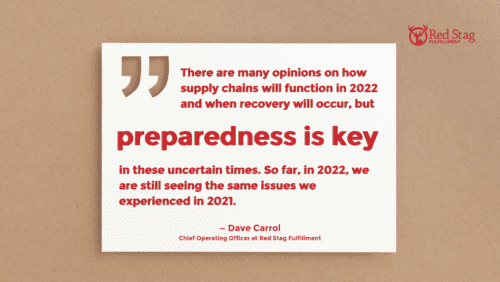One of the biggest challenges faced by online retailers is dead stock, meaning products that don’t get sold. Dead stock takes up space, saps resources, and erodes profits.
This article explores the different types of dead stock, how they’re caused, and what you can do to prevent dead stock from undermining the growth of your business.

TL;DR:
Dead stock essentials

Dead stock is inventory that can’t be sold, taking up warehouse space and tying up capital without generating revenue.

Six types include expired items, obsolete stock, seasonal merchandise, overstocked items, defective products, and items with no demand.

Dead stock causes financial losses, creates operational inefficiencies, and leads to emotional stress for business owners.

Prevention strategies include accurate demand forecasting, optimized inventory control, and partnering with a reliable 3PL like Red Stag Fulfillment.
What does “dead stock” mean?

Dead stock is inventory that you’re unable to sell. Sometimes known as excess stock, it’s unlikely to ever move out of your warehouse and generate revenue. It differs from returned stock (products sent back by customers) and safety stock (intentional extra inventory for unexpected demand).

What makes dead stock bad is that it grows unintentionally, becoming a stagnant investment that takes up valuable inventory space and incurring additional holding costs. As you accumulate dead stock, you also tie up more of your resources in products that are unlikely to ever give a return on your investment.
Basically, it’s good to avoid dead stock whenever you can. Good inventory management software—along with the right fulfillment partner—can go a long way to help.
Types of dead stock
There are six main types of dead stock, each with its own reason for why items can’t be sold.

Expired items: Products that have passed their expiration date, rendering them unsellable. This is especially important for consumable products, like food and supplements.

Obsolete stock: Products that have been superseded by the release of a newer version. Think design updates or constantly evolving fashion trends.

Out-of-season merchandise: Seasonal items that fail to sell before the season’s end and are unlikely to be sold the following season.

Overstocked items: Products whose purchase was fueled by overly optimistic sales projections that never materialized. (Don’t worry. This happens to just about every ecommerce company at least once.)

Defective or damaged products: Items that can’t be sold due to manufacturing defects or because they’ve been damaged during handling or storage. Ask your fulfillment partner about their damage guarantee. (Hint: they probably don’t have one.)

Products with no customer demand: Merchandise that didn’t resonate with your target audience, often due to a lack of quality research and audience insights.

The causes of dead stock
There are several merchandising and inventory errors that can lead to excess stock.
Over-ordering
Among the most common culprits behind dead stock is the temptation to order more products than you can realistically sell in a given timeframe. Businesses can get swept up in a wave of backorders or overly optimistic sales projections, or fall prey to the allure of bulk discounts without considering the potential for excess inventory. This can result in a warehouse filled with products that have lost their appeal.

PRO TIP: When ordering inventory, use the “just enough” principle rather than “just in case.” Focus on data-driven ordering based on historical sales patterns and realistic forecasts rather than optimistic projections or bulk discount temptations.
Inaccurate demand forecasting
Poor estimations of customer demand can result in overstocking products that fail to sell, resulting in dead stock. Under-stocking items in high demand can also lead to lost revenue if customers are unwilling to wait for the item to be restocked. Finding this delicate balance is particularly challenging if your business sells seasonal or trend-driven products
Poor sales or marketing efforts
Even with the right products in stock, they won’t sell themselves. Without the right marketing, a beautifully crafted product can wind up sitting idly on a shelf—dead stock unsold due to a lack of sales expertise or market awareness
Neglecting quality control
The road to dead stock is often paved with good intentions but poor quality control. Defective or damaged items that slip through the cracks cannot be sold, tying up your capital. Worse, you may have to devote resources to get rid of dead stock—a costly reminder of the importance of rigorous quality control.

The impact of dead stock on your business
Dead stock can have serious consequences for your business’s financial health and operational efficiency.
Financial losses

Key Takeaway: Dead stock ties up your working capital and represents a significant opportunity cost. The money invested in unsold products is unavailable for marketing, product development, or other growth initiatives. Additionally, it incurs ongoing storage costs and may require costly disposal processes.
The longer dead stock sits in the warehouse, the more susceptible it is to damage, which devalues the product further. In some cases, you may even incur disposal costs to get rid of dead stock from your inventory. This can be especially costly for perishable or regulated products that require special handling or disposal methods.
Operational inefficiencies
By occupying valuable warehouse space, dead stock eats into your storage capacity for profitable products. It also complicates inventory management and forecasting.
Dead stock that creates inaccurate inventory data can cause a ripple effect throughout your supply chain, leading to stock-outs of popular items or overstocking slow-moving products that then require costly markdowns. These inefficiencies can tarnish your brand if customers consistently encounter out-of-stock or heavily discounted products.
Emotional stress and frustration
Beyond the financial and operational impact, dealing with dead stock can take an emotional toll on business owners and their teams. Seeing your hard-earned money tied up in unsold products can be a tough reminder of the challenges and setbacks that come with running a business and might even sap the motivation and optimism of employees.
Moreover, accumulating dead stock can be a major source of stress. From conducting inventory audits to negotiating with liquidators and charities, dealing with dead stock can feel like a thankless task that distracts you from the mission of your business.

Strategies for preventing dead stock
Take a look at some of the steps you can take to avoid dead stock or at least mitigate some of its effects.
Improve the accuracy of demand forecasting
Demand forecasting is a critical factor in determining how much inventory you need to purchase and plays a pivotal role in avoiding dead stock.
Start by making sure that you understand your market completely. Base decisions about which products to offer on industry and customer research. Analyze historical sales data to identify patterns and trends, paying close attention to seasonal fluctuations and market shifts that may impact customer demand.
To further refine your forecasting, consider investing in inventory management software that can track sales velocity and provide real-time insights into product performance. This data can help you make informed decisions about when to restock and when to hold off on purchasing so you don’t wind up with dead stock weighing down your bottom line.
Additionally, implementing flexible stock replenishment strategies such as just-in-time (JIT) inventory management can help you maintain optimal stock levels without overcommitting to large purchases and increasing your risk of dead stock.
Optimize inventory control processes
Effective inventory management is crucial to avoid dead stock, especially for businesses dealing with perishable goods, where it’s essential to avoid spoilage and waste. Setting clear, data-driven reorder points and safety stock levels can help you maintain a balanced inventory while reducing the risk of overstocking.

NOTE: Regular inventory audits are key to identifying slow-moving items before they become dead stock. Implementing a robust inventory management system with real-time tracking capabilities can help you spot potential dead stock issues early and take corrective action.

Strategies for mitigating dead stock
If you ever find yourself with dead stock, don’t worry. There are strategies for minimizing its impact.
Implement strategic promotions and discounts
Strategic promotions and discounts can help you move those products off your shelves. Clearance sales are a popular way to get rid of dead stock quickly. You can also bundle dead stock with popular items to encourage customers to purchase the slow-moving products.
Explore alternative distribution and disposal methods
In some cases, you may need to look beyond traditional sales channels to dispose of dead stock. One possibility is offering your dead stock through different channels or online marketplaces in order to reach a different audience.

PRO TIP: Consider donating dead stock to charitable organizations for a tax write-off while supporting a good cause. This approach can turn a financial loss into a positive community impact and potential tax benefit.
Another is forging a partnership with another brand by giving them the merchandise—at cost or even for free—for bundling with their products. Remember, dead stock costs you money. So taking a loss with a give away can actually protect your bottom line in the long run.
Recycling or repurposing may be an option if your business deals with raw materials or components that can be used in other products or industries. By finding creative ways to dispose of dead stock, you can minimize waste and recoup some of your invested capital.

Red Stag Fulfillment: Your inventory management partner
As an ecommerce business owner, effective inventory management is crucial for avoiding the pitfalls of dead stock and ensuring the long-term success of your company. Partnering with a trusted fulfillment provider like Red Stag can help streamline your inventory management, hedge against lost revenue, and avoid carrying fees, lost inventory space, and other costly scenarios.
Red Stag Fulfillment specializes in helping ecommerce businesses optimize their inventory and keep their products moving. With a team of experienced professionals and advanced fulfillment infrastructure, we offer a range of 3PL services designed to help you minimize the risk of dead stock.
Our inventory management software provides real-time visibility into your stock levels, allowing you to track product performance, identify slow-moving items, and make data-driven decisions about when to restock or liquidate. We also offer a range of services to help you minimize the risk of dead stock, including:

Accurate order processing
By making sure that orders are picked, packed, and shipped accurately and efficiently, you can avoid the costly mistakes that can lead to returns and dead stock.

Flexible storage options
With strategically located fulfillment centers, you have flexible storage options that allow you to keep your inventory close to your customers. This reduces delivery times and costs while also minimizing your risk of overstocking and winding up with dead stock you can’t sell.

Value-added services
From kitting and assembly to custom packaging and labeling, Red Stag Fulfillment offers a range of value-added services that can help you differentiate your products and avoid the markdowns and liquidations that often accompany dead stock.
Stop letting dead stock drain your profits
Partnering with Red Stag Fulfillment gives you access to a team of fulfillment experts who provide valuable guidance for navigating dead stock and other inventory management challenges. Whether you’re looking to improve your demand forecasting, optimize your inventory levels, or develop a strategic liquidation plan, our team can help.











